Acids And Bases Notes
Check Out Our Results

OXFORD UNIVERSITY
(QS:3)

IMPERIAL COLLEGE
(QS:6)

CORNELL UNIVERSITY (QS:16)

45/45 (IBDP)
GEORGIA INSTITUTE

43/45 (IBDP)
KELLY SCHOOL
Theories of acids and bases
The role of acids and bases
- An acid is any hydrogen containing substance that is capable of donating a proton (hydrogen ion) to another substance.
- A base is a molecule or ion able to accept a hydrogen ion from an acid.
- The Arrhenius theory of acids and bases states that “an acid generates H+ ions in a solution whereas a base produces an OH– ion in its solution”.
- The Bronsted-Lowry theory defines “an acid as a proton donor and a base as a proton acceptor”.
- The Lewis definition of acids and bases describes “acids as electron-pair acceptors and bases as electron-pair donors”.
Arrhenius’s theory of acids and bases
- He defined an acid as a substance that ionizes in water to produce hydrogen ions, H+.
- An alkali, a soluble base, produces hydroxide ions, OH–.
- The combination of an acid and base is well known as a neutralization reaction involving the combination of the hydrogen ion and the hydroxide ion.
H+(aq) + OH– (aq) → H2O(l)
Brønsted–Lowry acids and bases
- This theory focuses on the transfer of H+ ions during an acid–base reaction: acids donate H+ while bases accept H+. For example, in the reaction between HCl and NH3:
HCl + NH3 ⇋ NH4+ + Cl–
- HCl transfers H+ to NH3 and so acts as an acid; NH3 accepts the H+ and so acts as a base
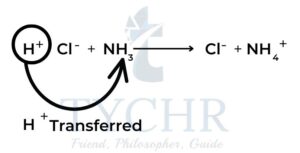
Figure 1: HCl transfers H+ to NH3. - Hydrogen atoms contain just one proton and one electron, so when they ionize by losing the electron, all that is left is the proton.
- Therefore H+ is equivalent to a proton, and we will use the two terms interchangeably here.
- The Brønsted–Lowry theory can therefore be stated as:
- a Brønsted–Lowry acid is a proton (H+) donor;
- a Brønsted–Lowry base is a proton (H+) acceptor.
- Let’s consider the acid–base reaction between a generic acid HA and base B:
HA + B ⇋ A– + BH+
- We can see that HA acts as an acid, donating a proton to B while B acts as a base, accepting the proton from HA.
- But if we look also at the reverse reaction, we can pick out another acid–base reaction: here BH+ is acting as an acid, donating its proton to A– while A– acts as a base accepting the proton from BH+.
- In other words acid HA has reacted to form the base A–, while base B has reacted to form acid BH+.
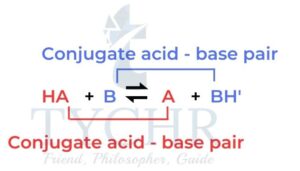
- Acids react to form bases and vice versa. The acid–base pairs related to each other in this way are called conjugate acid–base pairs, and you can see that they differ by just one proton.
Amphiprotic species
- An amphiprotic substance is one which can act as both a proton donor and a proton acceptor.
- Some substances have the ability to act as either a Brønsted–Lowry acid or a Brønsted–Lowry base depending on the reaction in which they are taking part.
- These species are said to be amphiprotic. For example, the water molecule can donate a proton in a reaction, thus acting as a Brønsted– Lowry acid. It can also accept a proton, acting as a Brønsted–Lowry base.
- All 2-amino acids contain a weakly acidic carboxyl group and a weakly basic amino group.
- In the ionized form (a zwitterion, figure 2) the compound acts as an acid in the presence of a strong base, donating a proton. In the presence of a strong acid it acts as a base and accepts a proton.
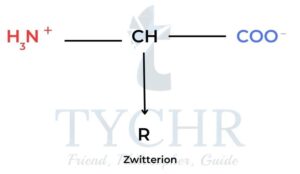
Figure 2: A 2-amino acid is amphiprotic
Properties of acids and bases
Properties of acids and bases
- Acids and bases perform many useful functions in daily life.
- Caustic soda (concentrated sodium hydroxide) dissolves grease and oil deposits that can block domestic and commercial drains. Phosphoric acid is an effective rust remover, changing iron(III) oxide (Fe2O3, rust) into iron(III) phosphate, FePO4.
- Ammonia is used as a general cleaner while mild acids such as vinegar are sometimes put on wasp stings, which are alkaline.
Acids |
Bases |
|
taste sour |
taste bitter |
|
pH < 7.0 |
pH > 7.0 |
|
litmus is red |
litmus is blue |
|
phenolphthalein is colourless |
phenolphthalein is pink |
|
methyl orange is red |
methyl orange is yellow |
Table 1: General properties of acids and bases and their effects on some common indicators
The reactions of acids with metals, bases, and carbonates
- Most acids react with metals, metal oxides, hydroxides, hydrogen carbonates, and carbonates.
- All these reactions produce a salt. Sodium chloride is referred to as “common salt” but this is just one example of a salt, which is a compound composed of an anion and cation.
- Metals that are found above hydrogen in the activity series (sub-topic 9.1) react with acids to form a salt and hydrogen gas:
acid + metal → salt + hydrogen
2HCl(aq) + Zn(s) → ZnCl2(aq) + H2(g)
H2SO4(aq) + Fe(s) → FeSO4(aq) + H2(g)
2CH3COOH(l) + 2Na(s) ⇋ 2CH3COONa(l) + H2(g)
- These reactions give off hydrogen gas at different rates according to the reactivity of the metal and the strength and concentration of the acid.
- The salt produced in neutralization reactions is composed of a cation from the base and an anion from the acid. Common examples of bases include metal hydroxides, metal oxides, and ammonium hydroxide, which is a weak base:
acid + base → salt + water
2HCl(aq) + Ca(OH)2(aq) → CaCl2(aq) + 2H2O(l)
H2SO4(aq) + CaO(s) → CaSO4(s) + H2O(l)
CH3COOH(aq) + NH4OH(aq) ⇋ CH3COONH4(aq) + H2O(l)
- Metal carbonates and hydrogencarbonates react with acids to produce carbon dioxide and water:
acid + metal carbonate/metal hydrogencarbonate → salt + carbon dioxide + water
2HCl(aq) + Na2CO3(s) → 2NaCl(aq) + CO2(g) + H2O(l)
HCl(aq) + NaHCO3(s) → NaCl(aq) + CO2(g) + H2O(l)
Acid–base titrations
- Neutralization reactions are often used in the laboratory to calculate the exact concentration of an acid or an alkali when the other concentration is known.
- The solution of known concentration is known as the standard solution.
- The technique known as acid–base titration involves reacting together a carefully measured volume of one of the solutions, and adding the other solution gradually until the equivalence point is reached where they exactly neutralize each other.
- A convenient way to determine when the equivalence point has been reached is to use an indicator, chosen to change colour as the acid and base exactly neutralize each other.
- For example, titration can be used in the following experiments:
- to calculate the concentration of ethanoic acid in vinegar by titration with a standard solution of aqueous sodium hydroxide, using phenolphthalein indicator;
- to calculate the concentration of sodium hydroxide by titration with a standard solution of hydrochloric acid, using methyl orange indicator.
- A good indicator is one that gives a distinct or sharp colour change at the equivalence point.
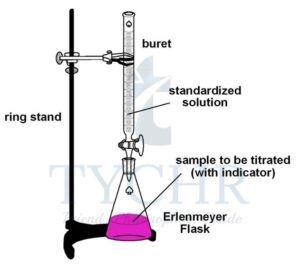
Figure 3: Simple titration apparatus.
The pH scale
The pH scale
- The pH scale is a simple and effective way of representing the concentration of hydrogen ions, [H+] in a solution.
- The use of a logarithmic scale to display hydrogen ion concentrations results in a simple visual scale that is accessible to non-scientists and valid for scientists.
pH = –log10 [H+]
- In other words, pH is the negative number to which the base 10 is raised to give the [H+]. This can also be expressed as: [H+] = 10–pH
- A solution that has [H+] = 0.1 mol dm–3 ⇒ [H+] = 10–1 mol dm–3 ⇒ pH = 1.
- A solution that has [H+] = 0.01 mol dm–3 ⇒ [H+] = 10–2 mol dm–3 ⇒ pH = 2.
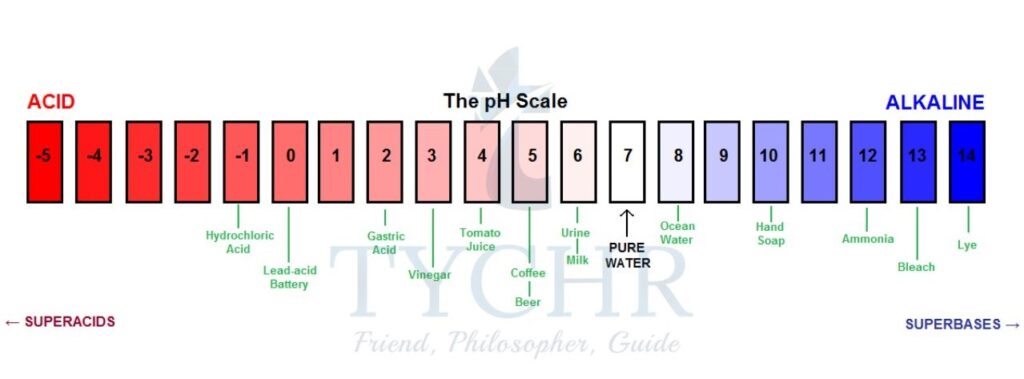
- pH numbers are usually positive and have no units.
- The pH number is inversely related to the [H+].
- A change of one pH unit represents a 10-fold change in [H+].
Calculating pH
- Strong acids and strong bases are assumed to completely ionize in aqueous solutions.
- Therefore the concentration of a strong monoprotic acid will be the same as the concentration of the hydrogen ion.
- A 0.1 mol dm-3 solution of hydrochloric acid equates to [H+] = 0.1 mol dm-3.
- From the definition of pH we can: (i) calculate the value of pH from a known concentration of H+; (ii) calculate the concentration of H+ from a given pH.
Measuring pH
- An easy way to measure pH is with universal indicator paper or solution.
- The substance tested will give a characteristic colour, which can then be compared with a colour chart supplied with the indicator.
- A more objective and usually more accurate means is by using a pH meter or probe that directly reads the [H+] concentration through a special electrode. pH meters can record to an accuracy of several decimal points
Ionization of water
- The pH scale covers both the acidic and alkaline regions of aqueous systems. When considering solutions involving strong and weak bases, we need to examine the relationship between hydrogen ion and hydroxide ion concentrations.
- Water can undergo auto-ionization, according to the following equilibrium expression
H2O(l) ⇋ H+(aq) + OH– (aq)
Kc =
- as [H2O] is constant, Kw = [H+][OH– ] = 1.0 × 10-14 at 298 K.
- This expression is the ion product constant for water. In pure water,
[H+] = [OH– ] = = 1.0 × 10-7
The relationship between H+ and OH– is inverse
- Because the product [H+] × [OH–] gives a constant value, it follows that the concentrations of these ions must have an inverse relationship.
- In other words, in aqueous solutions the higher the concentration of H+ the lower the concentration of OH–.
- Solutions are defined as acidic, neutral, or basic according to their relative concentrations of these ions as shown below.
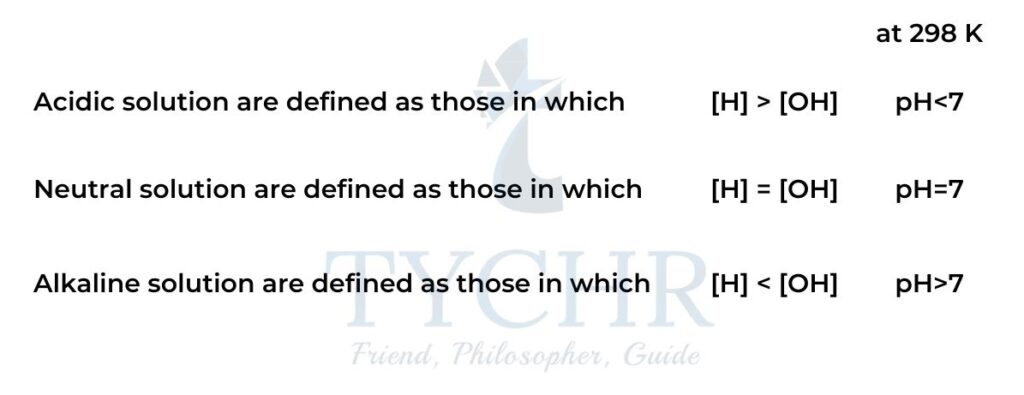
- The concentrations of H+ and OH– are inversely proportional in an aqueous solution.
Strong and weak acids and bases
The strength of an acid or base depends on its extent of ionization
- If this acid dissociates fully, it will exist entirely as ions in solution. It is said to be a strong acid. For example, hydrochloric acid, HCl, is a strong acid.
- The reaction is written without the equilibrium sign.
HCl(aq) + H2O(l) → H3O+(aq) + Cl–(aq)
- If, on the other hand, the acid dissociates only partially, it produces an equilibrium mixture in which the undissociated form dominates. It is said to be a weak acid.
- For example, ethanoic acid, CH3COOH, is a weak acid.
CH3COOH(aq) + H2O(l) ⇋ H3O+(aq) + CH3COO–(aq)
- Here it is essential to use the equilibrium sign for its dissociation reaction.
- Strong acids and strong bases ionize almost completely in solution; weak acids and weak bases ionize only partially in solution.
Distinguishing between strong and weak acids and bases
- Due to their greater ionization in solution, strong acids and strong bases will contain a higher concentration of ions than weak acids and weak bases.
1.) Electrical conductivity
- Electrical conductivity of a solution depends on the concentration of mobile ions.
- Strong acids and strong bases will therefore show higher conductivity than weak acids and bases – so long as solutions of the same concentration are compared.
2.) Rate of reaction
- The reactions of acids depend on the concentration of H+
- They will therefore happen at a greater rate with stronger acids.
3.) pH
- Because it is a measure of the H+ concentration, the pH scale can be used directly to compare the strengths of acids (providing they are of equal molar concentration).
- Remember the higher the H+ concentration, the lower the pH value.
- Universal indicator or a pH meter can be used to measure pH.
Acid deposition
Causes of acid deposition
- Acid deposition is the process by which acid-forming pollutants are deposited on the Earth’s surface.
- Increased industrialization and economic development in many parts of the world have led to rapidly increasing emissions of the nitrogen and sulfur oxides that cause acid rain, the most prevalent form of acid deposition.
- Acid rain refers to solutions with a pH below 5.6, and which therefore contain additional acids.
- The main contributors to acid rain are the oxides of sulfur and nitrogen, which are primary pollutants.
- Acid deposition is a broader term than acid rain and includes all processes by which acidic components as precipitates or gases leave the atmosphere.
- There are two main types of acid deposition:
- wet acid deposition: rain, snow, sleet, hail, fog, mist, dew fall to ground as aqueous precipitates;
- dry acid deposition: acidifying particles, gases fall to ground as dust and smoke, later dissolve in water to form acids.
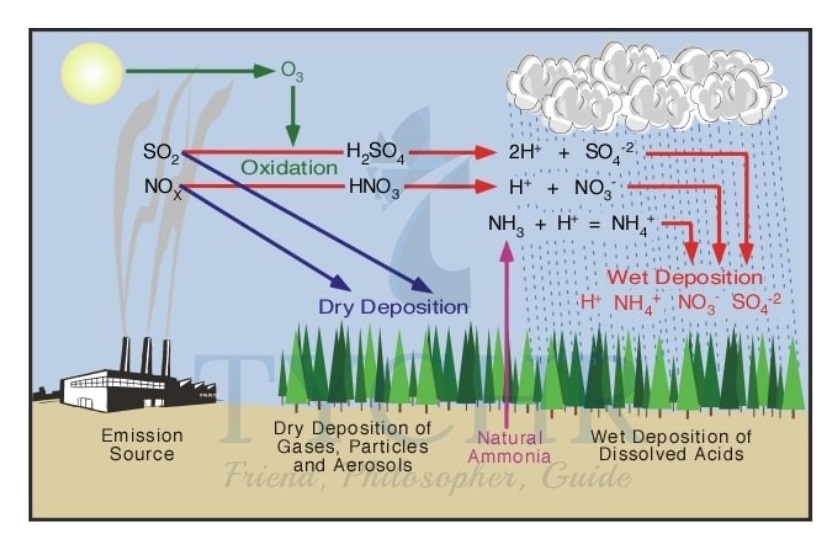
Effects of acid deposition
1.) Impact on materials
- The building materials marble and limestone are both forms of calcium carbonate, CaCO3. Both sulfur dioxide (in dry deposition) and sulfuric acid (in acid rain) react with this, forming the calcium salt, CaSO4:
2CaCO3(s) + 2SO2(g) + O2(g) → 2CaSO4(aq) + 2CO2(g)
CaCO3(s) + H2SO4(aq) → CaSO4(aq) + H2O(l) + CO2(g)
- As calcium sulfate is somewhat more soluble than calcium carbonate, it washes out of the limestone or flakes off.
- Calcium sulfate has a greater molar volume than calcium carbonate, so its formation causes expansion and stress in the stonework. A similar reaction occurs with nitric acid, forming the soluble nitrate salt:
CaCO3(s) + 2HNO3(aq) → Ca(NO3)2(aq) + H2O(l) + CO2(g)
- These reactions all lead to erosion of structures, and many historic buildings and statues have suffered in this way.
2.) Impact on plant life
- Acid rain has been shown to be a direct cause of slower growth, injury, or death of plants. One of its effects is to cause important minerals such as Mg2+, Ca2+, and K+ held in the soil to become soluble and so wash away in a process called leaching, before they can be absorbed by plants.
- Without sufficient Mg2+ ions, for example, a plant cannot synthesize chlorophyll and so cannot make its food through photosynthesis.
- At the same time, acid rain causes the release of substances that are toxic to plants, such as Al3+, which damage plant roots.
3.) Impact on water
- Acid rain has caused a number of lakes to become ‘dead’ – unable to support life. Many fish including trout and perch cannot survive at pH values below 5.
- Below pH 4, rivers are effectively dead as toxic Al3+ ions normally trapped in the rock as insoluble aluminium hydroxide leach out under acid conditions:
Al(OH)3(s) + 3H+(aq) → Al3+(aq) + 3H2O(l)
- Aluminium ions interfere with the operation of the fish’s gills and reduce their ability to take in oxygen.
- Acid rain also contributes to an additional problem known as eutrophication.
- This is over-fertilization of bodies of water, and can be caused by nitrates present in acid rain.
- It results in algal blooms leading to oxygen depletion, and sometimes the death of the lake or stream.
4.) Impact on human health
- Acid rain does not directly affect human health but its components can react to form fi ne sulfate and nitrate particles that can travel long distances and be present in inhaled air.
- These particles irritate the respiratory tract and increase the risk of illnesses such as asthma, bronchitis, and emphysema.
- They can also cause irritation to the eyes. The release of toxic metal ions such as Al3+, Pb2+, and Cu2+ by the reaction of acid rain on metal structures such as pipes is also a potential health risk.
Pre- and post-combustion technologies
- Pre-combustion methods to reduce sulfur emissions refer to techniques used on fuels before their combustion. Physical cleaning or mineral beneficiation involves crushing coal, followed by flotation that reduces the amounts of sulfur and other impurities. Combinations of different pre-combustion methods result in the removal of up to 80–90% of inorganic sulfur.
- Post-combustion methods focus on several complementary technologies to remove sulfur dioxide, nitrogen oxides, heavy metals and dioxins from the combustion gases before they are released into the atmosphere. For example, calcium oxide or lime will react with sulfur dioxide and remove it from flue gases:
CaO(s) + SO2(g) → CaSO3(s)
Lewis acids and bases
Defining Lewis acids and bases
- Gilbert Lewis, whose name famously belongs to electron dot structures for representing covalent bonding, used such structures in interpreting Brønsted–Lowry theory.
- Realizing that the base must have a lone pair of electrons, he reasoned that the entire reaction could be viewed in terms of the electron pair rather than in terms of proton transfer.
- For example, the reaction previously described in which ammonia acts as a base can be represented as follows:
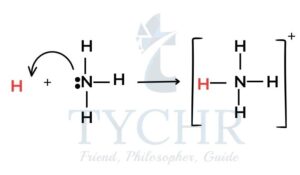
- The curly arrow (shown in blue) is a convention used to show donation of a pair of electrons. H+ is acting as an electron pair acceptor and the nitrogen atom in ammonia is acting as an electron pair donor.
- From such thinking Lewis developed a new, broader definition of acids and bases.
- A Lewis acid is a lone pair acceptor.
- A Lewis base is a lone pair donor.
Nucleophiles and electrophiles
- A nucleophile (‘likes nucleus’) is an electron-rich species that donates a lone pair to form a new covalent bond in a reaction.
- An electrophile (‘likes electrons’) is an electron-deficient species that accepts a lone pair from another reactant to form a new covalent bond.
- These terms are often used to describe reactions in terms of electron-rich nucleophiles attacking electron-deficient electrophiles, and are depicted using curly arrows to show electron movements.
- In other words, a nucleophile is a Lewis base and an electrophile is a Lewis acid.
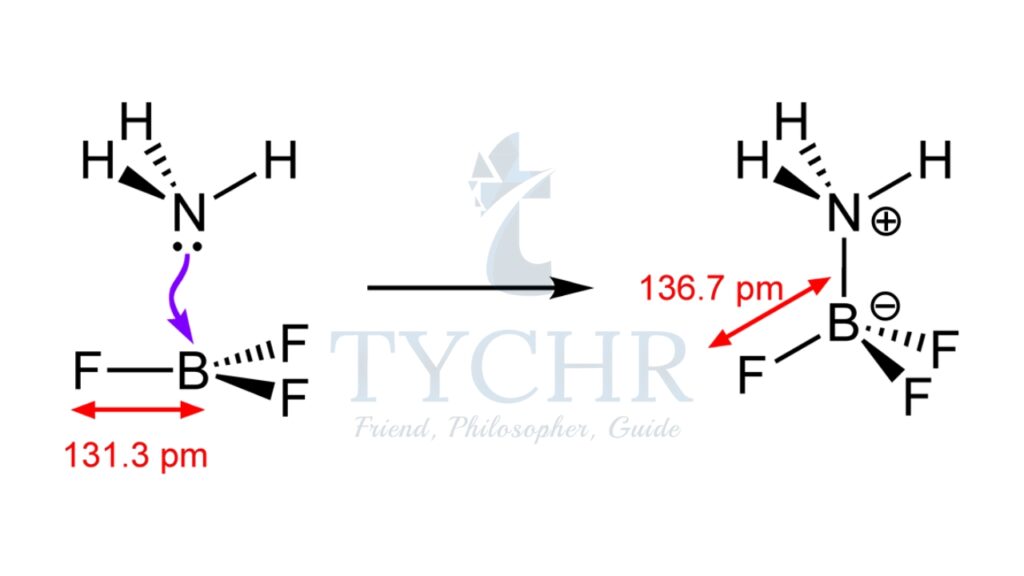
Comparison of Brønsted–Lowry and Lewis theories of acids and bases
- Although all Brønsted–Lowry acids are Lewis acids, not all Lewis acids are Brønsted– Lowry acids. The term Lewis acid is usually reserved for those species which can only be described by Lewis theory, that is, those that do not release H+.
- Many reactions cannot be described as Brønsted–Lowry acid–base reactions, but do qualify as Lewis acid–base reactions. These are reactions where no transfer of H+ occurs.
Theory |
Definition of acid |
Definition of base |
|
Brønsted–Lowry |
proton donor |
proton acceptor |
|
Lewis |
electron pair acceptor |
electron pair donor |
Table 2: Comparison of Brønsted–Lowry and Lewis theories
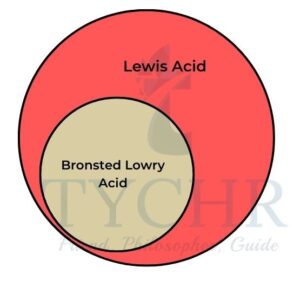
Calculations involving acids and bases
The strengths of acids and the acid dissociation constant
- Strong acids are assumed to be completely ionized in water, the reaction effectively going to completion.
- The conjugate base of a strong acid has almost no affinity for a proton.
- The following general equilibrium constant expression, Kc, can be written for the reaction of a weak acid HA with water:
HA(aq) + H2O(l) ⇋ A (aq) + H3O+(aq)
Kc= [A ][H3O+]/[HA][H2O]
- In this reaction [H2O] is considered a constant, and can be removed from the expression. The resulting expression represents the acid dissociation constant Ka:
Ka = [A ][H3O+]/[HA]
- A weak base B will also ionize in water. The following expression represents the base dissociation constant Kb:
B(aq) + H2O(l) ⇋ BH+(aq) + OH (aq)
Kb = [BH+][OH ]/[B]
Calculating Ka and Kb
- There are many weak acids and bases that undergo partial ionization in water. The strength of a weak acid or weak base can be expressed quantitatively by determining the dissociation constant at a given temperature.
- The stronger the acid, the greater the concentration of hydrogen ions in solution at equilibrium. This corresponds to a larger Ka Similarly, the stronger the base, the larger the value of Kb.
Ka and Kb for a conjugate acid–base pair
- The relationship between the acid dissociation constant for a weak acid and the base dissociation constant of its conjugate base can be useful in calculations. For example, ethanoic acid partially dissociates in water:
CH3COOH(aq) ⇋ CH3COO (aq) + H+(aq)
Ka = [CH3COO ][H+]/[CH3COOH]
- The conjugate base of ethanoic acid is the ethanoate ion, CH3COO–. It reacts with water according to the following equation.
CH3COO– (aq) + H2O(l) ⇋ CH3COOH(aq) + OH– (aq)
Kb = [CH3COOH][OH ]/[CH3COO ]
- Combining these expressions:
Ka Kb = ([CH3COO−][H+] [CH3COOH]) × ([CH3COOH][OH−] [CH3COO−]) = [H+][OH–] = Kw
- In summary: Ka Kb = Kw
- Other forms of this equation are useful in applying the relationship:
Ka = 𝐊𝐰𝐊𝐛 and Kb = 𝐊𝐰𝐊𝐚
- The stronger the acid:
- the larger the Ka
- the weaker the conjugate base
- the smaller the Kb of the conjugate base.
- The stronger the base:
- the larger the Kb
- the weaker the conjugate acid
- the smaller the Ka of the conjugate acid.
The temperature dependence of Kw
- the ionic product constant Kw was defined: H2O(l) ⇋ H+(aq) + OH (aq)
Kw = [H+][OH–] = 1.0 × 10-14 at 298 K
- A rise in temperature will result in the forward reaction being favoured, increasing the concentration of the hydrogen and hydroxide ions.
- This represents an increase in the magnitude of Kw and a decrease in the pH.
- Here we make the distinction between the neutrality and the pH of the solution.
- The pH of the solution decreases with an increase in the concentration of hydrogen ions.
- However, as the concentration of hydroxide ions increases by an equal amount, the solution remains neutral.
pKa and pKb
- The pH scale is a model that represents very small concentrations of hydrogen ions in a way that is easy to interpret, eliminating the use of negative exponents.
- In a similar way, while acid and base dissociation constants are good descriptors of the strengths of weak acids and bases their values can be very small and so difficult to compare.
- Therefore Ka and Kb values are represented as pKa and pKb respectively:
-log10 Ka = pKa Ka = 10 -pKa
-log10 Kb = pKb Kb = 10 -pKb
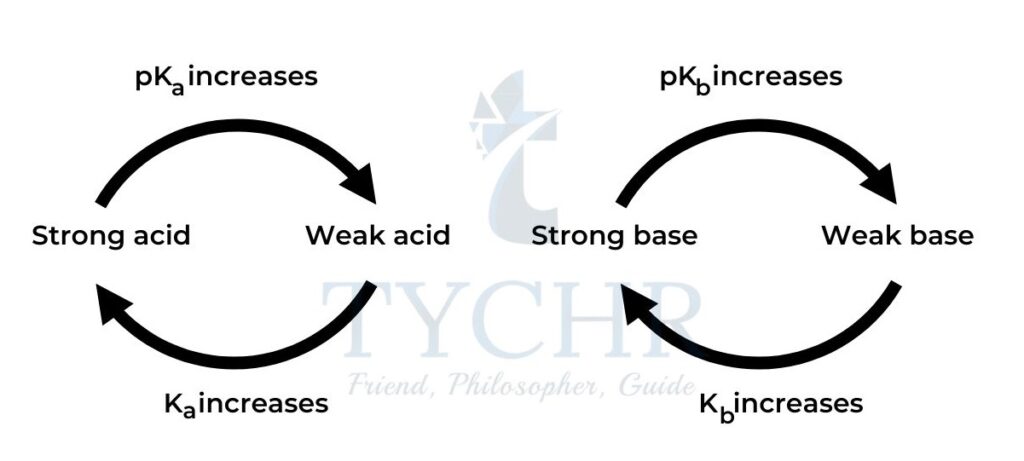
pH curves
Buffer solutions
- The addition of a single drop of a strong acid or base to water can result in a significant change in pH.
- A buffer is a solution that resists a change in pH upon the addition of small amounts of a strong base or strong acid, or upon the dilution of the buffer through the addition of water.
- A buffer may be composed of a weak acid and its conjugate base, or a weak base and its conjugate acid.
pH curves
- When a base is added to an acid in the neutralization reaction, there is a change in pH as we would expect.
- But this change does not show a linear relationship with the volume of base added, partly due to the logarithmic nature of the pH scale.
- The easiest way to follow the reaction is to record pH using a pH meter or data-logging device as a function of volume of base added, and plot these values as pH curves.
The titration of a strong acid with a strong base
- Consider the reaction of a strong acid with a strong base:
HCl(aq) + NaOH(aq) → NaCl(aq) + H2O(l)
or, in ionic form:
H+(aq) + OH– (aq) → H2O(l)
NaCl(aq) → Na+(aq) + Cl– (aq)
- Salts derived from a strong acid and a strong base do not react with hydrogen ions or hydroxide ions and so will not undergo hydrolysis. The salt sodium chloride forms a neutral aqueous solution.
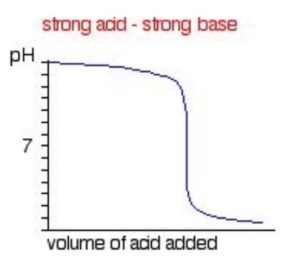
Figure 8: Titration curve for strong acid–strong base. - The following points can be deduced from the graph:
- 1) initial pH = 1 (pH of strong acid);
- 2) pH changes only gradually until equivalence;
- 3) very sharp jump in pH at equivalence: from pH 3 to pH 11;
- 4) after equivalence the curve flattens out at a high value (pH of strong base).
- 5) pH at equivalence = 7.
The titration of a weak acid with a strong base
- The reaction of the weak ethanoic acid with the strong base sodium hydroxide is shown in the following equation:
CH3COOH(aq) + NaOH(aq) → CH3COONa(aq) + H2O(l)
or, in ionic form:
CH3COOH(aq) + OH– (aq) → CH3COO– (aq) + H2O(l)
CH3COONa(aq) → CH3COO– (aq) + Na+(aq)
- The sodium ion will not undergo hydrolysis but the ethanoate ion is the conjugate base of a weak acid and so has a strong affinity for hydrogen ions.
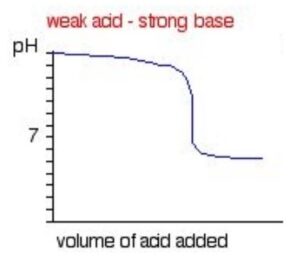
Figure 9: Titration curve for weak acid–strong base - The following points can be deduced from the graph:
1) initial pH fairly high (pH of weak acid);
2) pH stays relatively constant until equivalence – labelled as buffer region;
3) jump in pH at equivalence from about pH 7.0–11.0, which is not as much of a jump as for a strong acid–strong base titration;
4) after equivalence the curve flattens out at a high value (pH of strong base);
5) pH at equivalence is > 7.
The titration of a weak base with a strong acid
- he reaction between hydrochloric acid and ammonia is shown in the following equation:
HCl(aq) + NH3(aq) → NH4Cl(aq)
or, in ionic form:
H+(aq) + NH3(aq) → NH4+(aq)
NH4Cl(aq) → NH4+(aq) + Cl– (aq)
- The chloride ion, Cl is the conjugate base of the strong acid hydrochloric acid, HCl and has almost no affinity for hydrogen ions.
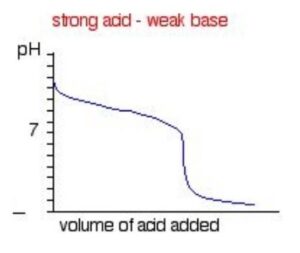
Figure 10: Titration curve for strong acid–weak base. - The following points can be deduced from the graph:
1) initial pH =1 (strong acid);
2) pH stays relatively constant through the buffer region to equivalence;
3) jump in pH at equivalence from about pH 3.0–7.0;
4) after equivalence the curve flattens out at a fairly low pH (pH of weak base);
5) pH at equivalence is < 7.
The titration of a weak base with a weak acid
- Salts derived from a weak acid and a weak base will undergo hydrolysis in water and the resulting pH of the aqueous solution depends on the relative strengths of the acid (Ka) and base (Kb). Ammonium ethanoate, CH3COONH4 forms a neutral aqueous solution: NH3(aq) + CH3COOH(aq) → CH3COONH4(aq)
or, in ionic form:
NH3(aq) + CH3COOH(aq) → CH3COO– (aq) + NH4+(aq)
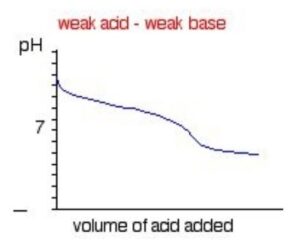
- The following points can be deduced from the graph:
- 1) initial pH is fairly high (pH of weak acid);
- 2) addition of base causes the pH to rise steadily;
- 3) change in pH at the equivalence point is much less sharp than in the other titrations;
- 4) after equivalence the curve flattens out at a fairly low pH (pH of weak base).
Indicators
- An indicator is typically a weak acid or a weak base that displays a different colour in acidic or alkaline environments. Many indicators in aqueous solutions behave as weak acids:
HIn(aq) ⇋ H+(aq) + In– (aq)
colour A colour B
- An indicator can also be a weak base.
BOH(aq) ⇋ B+(aq) + OH– (aq)
colour A colour B
- For such indicators, colour A is observed in alkaline solutions while colour B appears in the presence of acids.
Selection of an indicator
- Because indicators give us a visible cue when pH changes, they can be used to identify the equivalence points in titrations, given that this is the place where the pH changes most dramatically.
- An indicator will be effective in signalling the equivalence point of a titration when its end-point coincides with the pH at the equivalence point.
- This means that different indicators must be used for different titrations, depending on the pH at the equivalence point.
- The following steps will help you to choose an appropriate indicator for a particular titration.
- Determine what combination of weak and strong acid and base are reacting together.
- Deduce the pH of the salt solution at equivalence from the nature of the parent acid and base.
- Choose an indicator with an end-point in the range of the equivalence point by consulting data tables.
- For example, in the titration of a weak acid with a strong base the equivalence point occurs in the range pH 7–11.
- An appropriate indicator would therefore be one whose end-point lies in this range, such as phenolphthalein (end-point range 8.2–10.0) as shown in Figure 12.
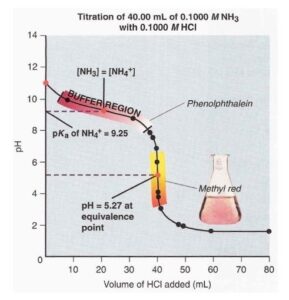
Figure 12: A weak acid– strong base titration showing how phenolphthalein will change colour and so effectively signal when equivalence is reached.
Titration |
Indicator |
pKa |
pH range |
Acidic colour |
Alkaline Colour |
|
strong acid– strong base |
phenol red |
7.9 |
6.8–8.4 |
yellow |
red |
|
strong acid– weak base |
methyl orange |
3.7 |
3.1–4.4 |
red |
yellow |
|
weak acid– strong base |
phenolphthalein |
9.6 |
8.3–10.0 |
colourless |
pink |
Table 3: Some acid–base indicators commonly used in titrations

